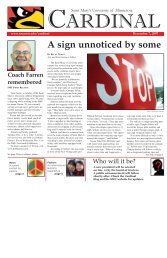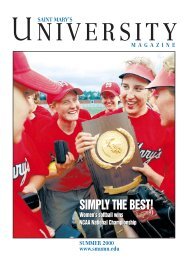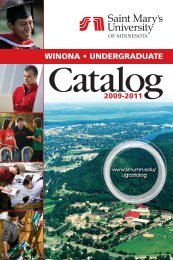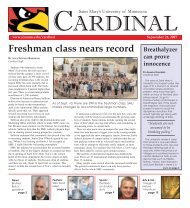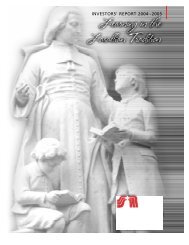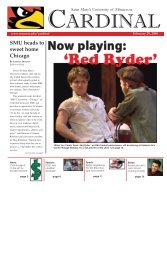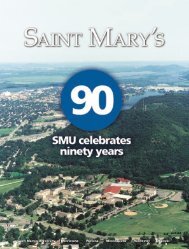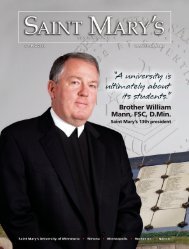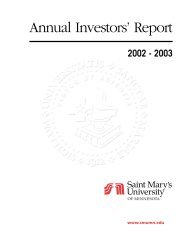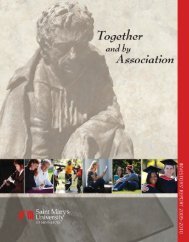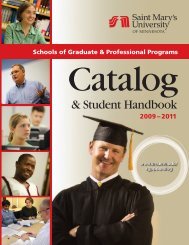PDF version - Saint Mary's University of Minnesota
PDF version - Saint Mary's University of Minnesota
PDF version - Saint Mary's University of Minnesota
Create successful ePaper yourself
Turn your PDF publications into a flip-book with our unique Google optimized e-Paper software.
Physics<br />
P111 Earth and the Solar System<br />
P340 Classical Mechanics<br />
P410 Physics Directed Research<br />
C. Three <strong>of</strong> the following (either P314 or P315 and either C332 or P380):<br />
C332 Physical Chemistry II with Laboratory<br />
P314 Digital Systems with Laboratory<br />
P315 Electronic Circuits (at WSU)<br />
P344 Mathematical Methods for Science<br />
P360 Electricity & Magnetism I<br />
P380 Quantum Mechanics I<br />
D. Required education course work<br />
Physics Minor (20 credits):<br />
A. All <strong>of</strong> the following:<br />
M151 Calculus I<br />
M152 Calculus II<br />
P201 Introductory Physics I<br />
P202 Introductory Physics I Laboratory<br />
P211 Introductory Physics II<br />
P212 Introductory Physics II Laboratory<br />
P304 Introduction to Modern Physics with Laboratory<br />
B. Two additional upper-division physics courses.<br />
Department Courses<br />
P111 The Earth and the Solar System 3 credits<br />
This course examines physical, geological, and astronomical processes involved in shaping the<br />
Earth and other planets. The geological processes acting on the Earth and the natural history <strong>of</strong> the<br />
Earth are studied first, and then used to examine the other bodies <strong>of</strong> the solar system, studying how<br />
the physical characteristics <strong>of</strong> the planets influence and are influenced by the same basic processes<br />
operating in different ways. Topics include: the properties <strong>of</strong> Earth materials, the evolution <strong>of</strong> the Earth<br />
and geological structures, matter and energy in the Earth system, the Earth in the solar system and<br />
the universe, fundamental issues <strong>of</strong> planetary science, and fundamentals <strong>of</strong> observational astronomy<br />
and objects in the sky (moon phases, properties <strong>of</strong> orbits, etc.). Offered every spring. Prerequisite:<br />
mathematics competency.<br />
P113 Physics <strong>of</strong> Sound and Music 3 credits<br />
This course is an exploration <strong>of</strong> the fundamental physical concepts relating to sound (vibrations<br />
and waves, overtones, Fourier synthesis and analysis) and its perception (physiology, physics, and<br />
psychophysics <strong>of</strong> hearing) and measurement (transducers and the decibel scale); sound recording<br />
and reproduction (analog and digital); musical acoustics (temperament and pitch; families <strong>of</strong> musical<br />
instruments; speech and the human vocal tract); and the acoustics <strong>of</strong> enclosures. Offered in alternate fall<br />
semesters. Prerequisite: mathematics competency.<br />
P121 Astronomy: The Stars and Beyond 3 credits<br />
This general-education level course focuses on three broad topics in astronomy: the tools <strong>of</strong> astronomy<br />
(the celestial sphere and the motion <strong>of</strong> objects in the sky; scientific method; light, spectra, and atomic<br />
structure; the astronomical distance scale; gravity and celestial mechanics); stars and stellar evolution<br />
(the Hertzsprung-Russell diagram, the main sequence, and stellar lifecycles); and galaxies and<br />
cosmology (Hubble’s Law, dark matter, evidence for the Big Bang, and theories <strong>of</strong> the early universe).<br />
The course meets for two hours <strong>of</strong> lecture and a two-hour laboratory each week, and includes some use<br />
<strong>of</strong> the telescope. Offered fall semester. Prerequisite: mathematics competency.<br />
170



